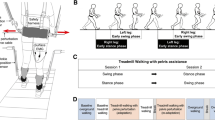Abstract
Treadmill training has been used as a promising technique to improve overground walking in patients with spinal cord injury (SCI). Previous findings showed that a gait pattern may adapt to a force perturbation during treadmill training and show aftereffects following removal of the force perturbation. We hypothesized that aftereffects would transfer to overground walking to a greater extent when the force perturbation was resisting rather than assisting leg swing during treadmill training. Ten subjects with incomplete SCI were recruited into this study for two treadmill training sessions: one using swing resistance and the other using swing assistance during treadmill stepping. A controlled resistance/assistance was provided to the subjects’ right knee using a customized cable-driven robot. The subjects’ spatial and temporal parameters were recorded during the training. The same parameters during overground walking were also recorded before and after the training session using an instrumented walkway. Results indicated that stride length during treadmill stepping increased following the release of resistance load and the aftereffect transferred to overground walking. In contrast, stride length during treadmill stepping decreased following the release of assistance load, but the aftereffect did not transfer to overground walking. Providing swing resistance during treadmill training could enhance the active involvement of the subjects in the gait motor task, thereby aiding in the transfer to overground walking. Such a paradigm may be useful as an adjunct approach to improve the locomotor function in patients with incomplete SCI.









Similar content being viewed by others
References
Aagaard P, Simonsen EB, Andersen JL, Magnusson P, Dyhre-Poulsen P (2002) Neural adaptation to resistance training: changes in evoked V-wave and H-reflex responses. J Appl Physiol 92:2309–2318
Amatachaya S, Keawsutthi M, Amatachaya P, Manimmanakorn N (2009) Effects of external cues on gait performance in independent ambulatory incomplete spinal cord injury patients. Spinal Cord 47:668–673
Bastian AJ (2008) Understanding sensorimotor adaptation and learning for rehabilitation. Curr Opin Neurol 21:628–633
Behrman AL, Harkema SJ (2000) Locomotor training after human spinal cord injury: a series of case studies. Phys Ther 80:688–700
Blanchette A, Bouyer LJ (2009) Timing-specific transfer of adapted muscle activity after walking in an elastic force field. J Neurophysiol 102:568–577
Colombo G, Joerg M, Schreier R, Dietz V (2000) Treadmill training of paraplegic patients using a robotic orthosis. J Rehabil Res Dev 37:693–700
Dietz V, Colombo G, Jensen L, Baumgartner L (1995) Locomotor capacity of spinal cord in paraplegic patients. Ann Neurol 37:574–582
Emken JL, Reinkensmeyer DJ (2005) Robot-enhanced motor learning: accelerating internal model formation during locomotion by transient dynamic amplification. IEEE Trans Neural Syst Rehabil Eng 13:33–39
Emken JL, Benitez R, Sideris A, Bobrow JE, Reinkensmeyer DJ (2007) Motor adaptation as a greedy optimization of error and effort. J Neurophysio 97:3997–4006
Field-Fote EC, Roach KE (2011) Influence of a locomotor training approach on walking speed and distance in people with chronic spinal cord injury: a randomized clinical trial. Phys Ther 91:48–60
Field-Fote EC, Lindley SD, Sherman AL (2005) Locomotor training approaches for individuals with spinal cord injury: a preliminary report of walking-related outcomes. J Neurol Phys Ther 29:127–137
Harkema SJ (2001) Neural plasticity after human spinal cord injury: application of locomotor training to the rehabilitation of walking. Neuroscientist 7:455–468
Houldin A, Luttin K, Lam T (2011) Locomotor adaptations and after effects to resistance during walking in individuals with spinal cord injury. J Neurophysiol 106:247–258
Kaelin-Lang A, Sawaki L, Cohen LG (2005) Role of voluntary drive in encoding an elementary motor memory. J Neurophysiol 93:1099–1103
Kawato M (1999) Internal models for motor control and trajectory planning. Curr Opin Neurobiol 9:718–727
Krawetz P, Nance P (1996) Gait analysis of spinal cord injured subjects: effects of injury level and spasticity. Arch Phys Med Rehabil 77:635–638
Lam T, Anderschitz M, Dietz V (2006) Contribution of feedback and feedforward strategies to locomotor adaptations. J Neurophysiol 95:766–773
Lotze M, Cohen LG (2006) Volition and Imagery in Neurorehabilitation. Cog Behav Neurol 19:135–140
Lotze M, Braun C, Birbaumer N, Anders S, Cohen LG (2003) Motor learning elicited by voluntary drive. Brain 126:866–872
Malone LA, Bastian AJ (2010) Thinking about walking: effects of conscious correction versus distraction on locomotor adaptation. J Neurophysiol 103:1954–1962
Murray MP, Drought AB, Kory RC (1964) Walking patterns of normal men. J Bone Joint Surg 46:335–360
Noble JW, Prentice SD (2006) Adaptation to unilateral change in lower limb mechanical properties during human walking. Exp Brain Res 169:482–495
Schmidt RA, Lee TD (2011) Motor control and learning: a behavioral emphasis. Human Kinetics, Champaign
Vasudevan EV, Torres-Oviedo G, Morton SM, Yang JF, Bastian AJ (2011) Younger is not always better: development of locomotor adaptation from childhood to adulthood. J Neurosci 31:3055–3065
Wernig A, Muller S (1992) Laufband locomotion with body weight support improved walking in persons with severe spinal cord injuries. Paraplegia 30:229–238
Wirz M, Zemon DH, Rupp R, Scheel A, Colombo G, Dietz V, Hornby TG (2005) Effectiveness of automated locomotor training in patients with chronic incomplete spinal cord injury: a multicenter trial. Arch Phys Med Rehabil 86:672–680
Wu M, Hornby G, Landry J, Roth H, Schmit B (2011) A cable-driven locomotor training system for restoration of gait in human SCI. Gait Posture 33:256–260
Zeni JA, Richards JG, Higginson JS (2008) Two simple methods for determining gait events during treadmill and overground walking using kinematic data. Gait Posture 27:710–714
Acknowledgments
This study is supported by Craig H. Neilsen Foundation, #124890 (Wu, M). The authors would like to thank Drs. T. George Hornby and James Stinear for the laboratory space support.
Author information
Authors and Affiliations
Corresponding author
Rights and permissions
About this article
Cite this article
Yen, SC., Schmit, B.D., Landry, J.M. et al. Locomotor adaptation to resistance during treadmill training transfers to overground walking in human SCI. Exp Brain Res 216, 473–482 (2012). https://doi.org/10.1007/s00221-011-2950-2
Received:
Accepted:
Published:
Issue Date:
DOI: https://doi.org/10.1007/s00221-011-2950-2




